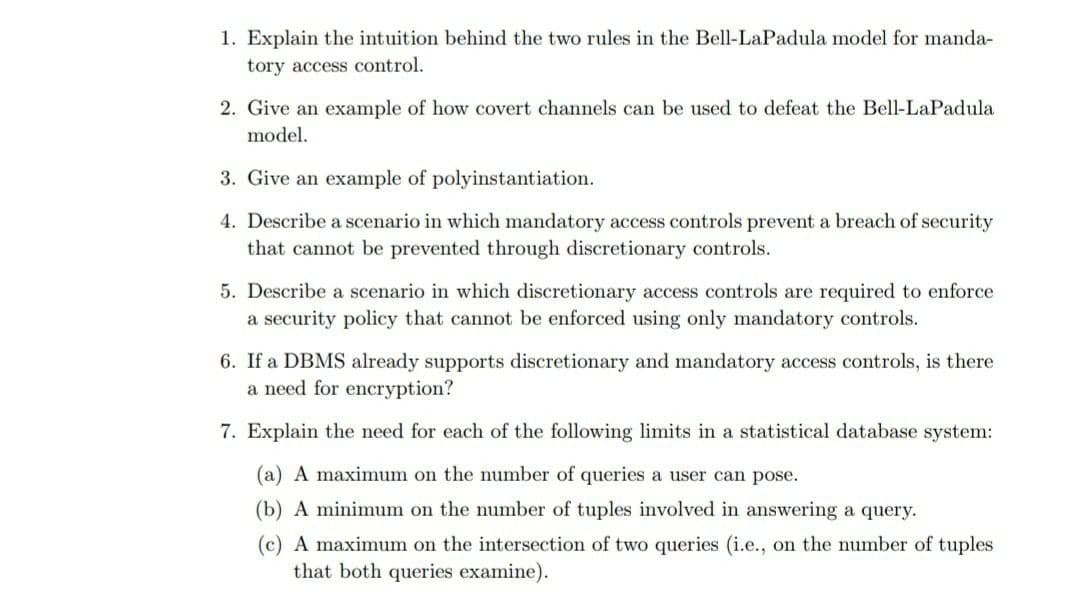1. Explain the intuition behind the two rules in the Bell-LaPadula model for manda- tory access control. 2. Give an example of how covert channels can be used to defeat the Bell-LaPadula model.
1. Explain the intuition behind the two rules in the Bell-LaPadula model for manda- tory access control. 2. Give an example of how covert channels can be used to defeat the Bell-LaPadula model.
Computer Networking: A Top-Down Approach (7th Edition)
7th Edition
ISBN:9780133594140
Author:James Kurose, Keith Ross
Publisher:James Kurose, Keith Ross
Chapter1: Computer Networks And The Internet
Section: Chapter Questions
Problem R1RQ: What is the difference between a host and an end system? List several different types of end...
Related questions
Question
ill report if incorret

Transcribed Image Text:1. Explain the intuition behind the two rules in the Bell-LaPadula model for manda-
tory access control.
2. Give an example of how covert channels can be used to defeat the Bell-LaPadula
model.
3. Give an example of polyinstantiation.
4. Describe a scenario in which mandatory access controls prevent a breach of security
that cannot be prevented through discretionary controls.
5. Describe a scenario in which discretionary access controls are required to enforce
a security policy that cannot be enforced using only mandatory controls.
6. If a DBMS already supports discretionary and mandatory access controls, is there
a need for encryption?
7. Explain the need for each of the following limits in a statistical database system:
(a) A maximum on the number of queries a user can pose.
(b) A minimum on the number of tuples involved in answering a query.
(c) A maximum on the intersection of two queries (i.e., on the number of tuples
that both queries examine).
Expert Solution
This question has been solved!
Explore an expertly crafted, step-by-step solution for a thorough understanding of key concepts.
Step by step
Solved in 2 steps

Recommended textbooks for you

Computer Networking: A Top-Down Approach (7th Edi…
Computer Engineering
ISBN:
9780133594140
Author:
James Kurose, Keith Ross
Publisher:
PEARSON

Computer Organization and Design MIPS Edition, Fi…
Computer Engineering
ISBN:
9780124077263
Author:
David A. Patterson, John L. Hennessy
Publisher:
Elsevier Science

Network+ Guide to Networks (MindTap Course List)
Computer Engineering
ISBN:
9781337569330
Author:
Jill West, Tamara Dean, Jean Andrews
Publisher:
Cengage Learning

Computer Networking: A Top-Down Approach (7th Edi…
Computer Engineering
ISBN:
9780133594140
Author:
James Kurose, Keith Ross
Publisher:
PEARSON

Computer Organization and Design MIPS Edition, Fi…
Computer Engineering
ISBN:
9780124077263
Author:
David A. Patterson, John L. Hennessy
Publisher:
Elsevier Science

Network+ Guide to Networks (MindTap Course List)
Computer Engineering
ISBN:
9781337569330
Author:
Jill West, Tamara Dean, Jean Andrews
Publisher:
Cengage Learning

Concepts of Database Management
Computer Engineering
ISBN:
9781337093422
Author:
Joy L. Starks, Philip J. Pratt, Mary Z. Last
Publisher:
Cengage Learning

Prelude to Programming
Computer Engineering
ISBN:
9780133750423
Author:
VENIT, Stewart
Publisher:
Pearson Education

Sc Business Data Communications and Networking, T…
Computer Engineering
ISBN:
9781119368830
Author:
FITZGERALD
Publisher:
WILEY